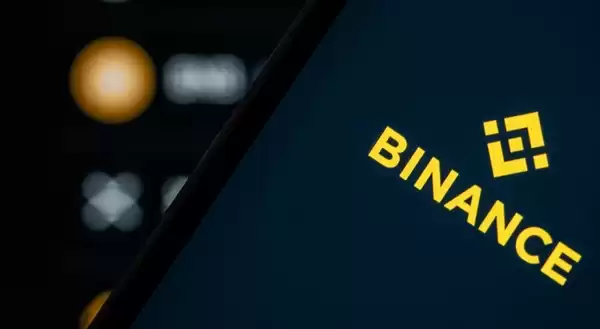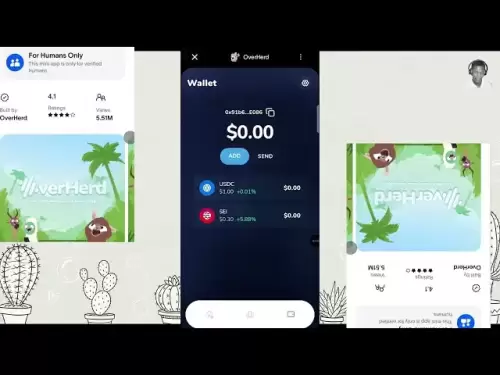-
 Bitcoin
Bitcoin $113600
-0.65% -
 Ethereum
Ethereum $3582
-2.02% -
 XRP
XRP $2.919
-4.02% -
 Tether USDt
Tether USDt $0.9999
-0.01% -
 BNB
BNB $749.8
-1.55% -
 Solana
Solana $162.1
-3.54% -
 USDC
USDC $0.9998
-0.01% -
 TRON
TRON $0.3318
-0.59% -
 Dogecoin
Dogecoin $0.1967
-4.77% -
 Cardano
Cardano $0.7148
-4.36% -
 Hyperliquid
Hyperliquid $37.30
-3.29% -
 Stellar
Stellar $0.3883
-4.29% -
 Sui
Sui $3.357
-4.00% -
 Bitcoin Cash
Bitcoin Cash $556.3
-1.84% -
 Chainlink
Chainlink $16.11
-4.08% -
 Hedera
Hedera $0.2344
-4.30% -
 Ethena USDe
Ethena USDe $1.001
0.00% -
 Avalanche
Avalanche $21.68
-4.66% -
 Litecoin
Litecoin $118.0
-3.37% -
 UNUS SED LEO
UNUS SED LEO $9.000
0.53% -
 Toncoin
Toncoin $3.161
-6.14% -
 Shiba Inu
Shiba Inu $0.00001193
-3.33% -
 Uniswap
Uniswap $9.434
-3.85% -
 Polkadot
Polkadot $3.577
-2.49% -
 Dai
Dai $0.9999
0.00% -
 Monero
Monero $288.7
-3.86% -
 Bitget Token
Bitget Token $4.209
-3.61% -
 Cronos
Cronos $0.1368
-1.06% -
 Pepe
Pepe $0.00001003
-4.60% -
 Aave
Aave $252.2
-3.73%
Difference between Binance leverage and contract
Binance leverage trading amplifies potential profits but increases risk, while contract trading introduces complexity but offers flexibility in speculating on crypto prices.
Nov 10, 2024 at 07:20 pm

Difference between Binance Leverage and Contract
Binance offers two main ways to trade cryptocurrencies with leverage: leverage trading and contract trading. Both options allow traders to amplify their potential profits, but they come with different risks and rewards.
In this article, we'll compare Binance leverage and contract trading, and provide detailed guidance on each option to help you make an informed decision about which one is right for you.
Binance Leverage Trading
Binance leverage trading allows traders to borrow funds from the exchange to increase their trading size. This can be a great way to increase potential profits, but it also comes with increased risk. If the market moves against you, you could lose more money than you originally invested.
Steps to Leverage Trade on Binance:
- Open a Binance account: If you don't already have one, you'll need to create a Binance account.
- Fund your account: Deposit funds into your Binance account to use as collateral for your leveraged trades.
- Choose a trading pair: Select the cryptocurrency pair you want to trade.
- Set your leverage: Select the amount of leverage you want to use. Binance offers leverage options ranging from 1x to 125x.
- Place your order: Enter the amount of cryptocurrency you want to trade and click the "Buy" or "Sell" button.
What is Binance Leverage Trading Used For?
Binance leverage trading is used to speculate on the price movements of cryptocurrencies. Traders can use leverage to increase their potential profits, but they must also be aware of the risks involved.
Benefits of Binance Leverage Trading:
- Increased profit potential: Leverage can amplify potential profits, allowing traders to make larger returns on their investments.
- Reduces trading costs: Leverage can reduce trading costs by allowing traders to trade with a smaller amount of capital.
- Diversification: Leverage can help traders diversify their portfolios by allowing them to trade a wider range of cryptocurrencies.
Risks of Binance Leverage Trading:
- Increased loss potential: Leverage can also amplify potential losses, making it possible to lose more money than you originally invested.
- Margin calls: If the market moves against you, Binance may issue a margin call, requiring you to deposit additional funds or close your position.
- Liquidation: If you fail to meet a margin call, Binance may liquidate your position, selling your cryptocurrency at a loss to cover your debt.
Binance Contract Trading
Binance contract trading allows traders to speculate on the future price of cryptocurrencies using contracts. These contracts are standardized agreements that allow traders to buy or sell a cryptocurrency at a predetermined price on a future date.
Steps to Contract Trade on Binance:
- Open a Binance account: If you don't already have one, you'll need to create a Binance account.
- Fund your account: Deposit funds into your Binance account to use as margin for your contract trades.
- Choose a trading pair: Select the cryptocurrency pair you want to trade.
- Select a contract type: Choose the type of contract you want to trade, such as a futures contract or an options contract.
- Set your order parameters: Enter the number of contracts you want to trade, the price you want to buy or sell at, and the expiration date for the contract.
- Place your order: Click the "Buy" or "Sell" button to place your order.
What is Binance Contract Trading Used For?
Binance contract trading is used to speculate on the future price movements of cryptocurrencies. Traders can use contracts to hedge against risk, or to gain exposure to cryptocurrencies without having to own them outright.
Benefits of Binance Contract Trading:
- Leverage: Contracts allow traders to use leverage to increase their potential profits.
- Flexibility: Contracts offer a variety of order types and expiration dates, giving traders flexibility in their trading strategies.
- Hedging: Contracts can be used to hedge against risk by providing a way to lock in a price for a future trade.
Risks of Binance Contract Trading:
- Complexity: Contract trading can be complex, and traders should fully understand the risks involved before trading.
- Market volatility: Cryptocurrencies can be volatile, and the price of a contract can fluctuate rapidly.
- Liquidation: If the market moves against you, Binance may liquidate your position, selling your contract at a loss to cover your debt.
Disclaimer:info@kdj.com
The information provided is not trading advice. kdj.com does not assume any responsibility for any investments made based on the information provided in this article. Cryptocurrencies are highly volatile and it is highly recommended that you invest with caution after thorough research!
If you believe that the content used on this website infringes your copyright, please contact us immediately (info@kdj.com) and we will delete it promptly.
- DeriW Mainnet: Zero Gas Fees Revolutionize On-Chain Derivatives Trading
- 2025-08-06 10:30:11
- IOTA, Cloud Mining, and Eco-Friendly Crypto: A New York Investor's Take
- 2025-08-06 10:30:11
- Kaspa (KAS) Price Prediction: August 6 - Will It Break Free?
- 2025-08-06 10:50:12
- Meme Coin Mania: Arctic Pablo's Token Burn Ignites Presale Frenzy
- 2025-08-06 10:50:12
- Pi Network, Holders, and Market Turbulence: Navigating the Crypto Storm
- 2025-08-06 10:55:12
- XRP, DOGE, and the Altcoin Darling Dilemma: Where's the Alpha?
- 2025-08-06 08:30:11
Related knowledge

Why is my Bitstamp futures position being liquidated?
Jul 23,2025 at 11:08am
Understanding Futures Liquidation on BitstampFutures trading on Bitstamp involves borrowing funds to open leveraged positions, which amplifies both po...

How to report Bitstamp futures for taxes?
Jul 30,2025 at 08:35am
Understanding Bitstamp Futures and Taxable EventsWhen trading Bitstamp futures, it’s essential to recognize that these financial instruments are treat...

Does Bitstamp offer inverse contracts?
Jul 23,2025 at 01:28pm
Understanding Inverse Contracts in Cryptocurrency TradingIn the realm of cryptocurrency derivatives, inverse contracts are a specific type of futures ...

What is the difference between futures and perpetuals on Bitstamp?
Jul 27,2025 at 05:08am
Understanding Futures Contracts on BitstampFutures contracts on Bitstamp are financial derivatives that allow traders to speculate on the future price...

How to find your Bitstamp futures trade history?
Jul 23,2025 at 08:07am
Understanding Bitstamp and Futures Trading AvailabilityAs of the current state of Bitstamp’s service offerings, it is critical to clarify that Bitstam...

Can I use a trailing stop on Bitstamp futures?
Jul 23,2025 at 01:42pm
Understanding Trailing Stops in Cryptocurrency TradingA trailing stop is a dynamic type of stop-loss order that adjusts automatically as the price of ...

Why is my Bitstamp futures position being liquidated?
Jul 23,2025 at 11:08am
Understanding Futures Liquidation on BitstampFutures trading on Bitstamp involves borrowing funds to open leveraged positions, which amplifies both po...

How to report Bitstamp futures for taxes?
Jul 30,2025 at 08:35am
Understanding Bitstamp Futures and Taxable EventsWhen trading Bitstamp futures, it’s essential to recognize that these financial instruments are treat...

Does Bitstamp offer inverse contracts?
Jul 23,2025 at 01:28pm
Understanding Inverse Contracts in Cryptocurrency TradingIn the realm of cryptocurrency derivatives, inverse contracts are a specific type of futures ...

What is the difference between futures and perpetuals on Bitstamp?
Jul 27,2025 at 05:08am
Understanding Futures Contracts on BitstampFutures contracts on Bitstamp are financial derivatives that allow traders to speculate on the future price...

How to find your Bitstamp futures trade history?
Jul 23,2025 at 08:07am
Understanding Bitstamp and Futures Trading AvailabilityAs of the current state of Bitstamp’s service offerings, it is critical to clarify that Bitstam...

Can I use a trailing stop on Bitstamp futures?
Jul 23,2025 at 01:42pm
Understanding Trailing Stops in Cryptocurrency TradingA trailing stop is a dynamic type of stop-loss order that adjusts automatically as the price of ...
See all articles

























































































